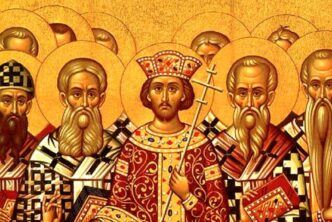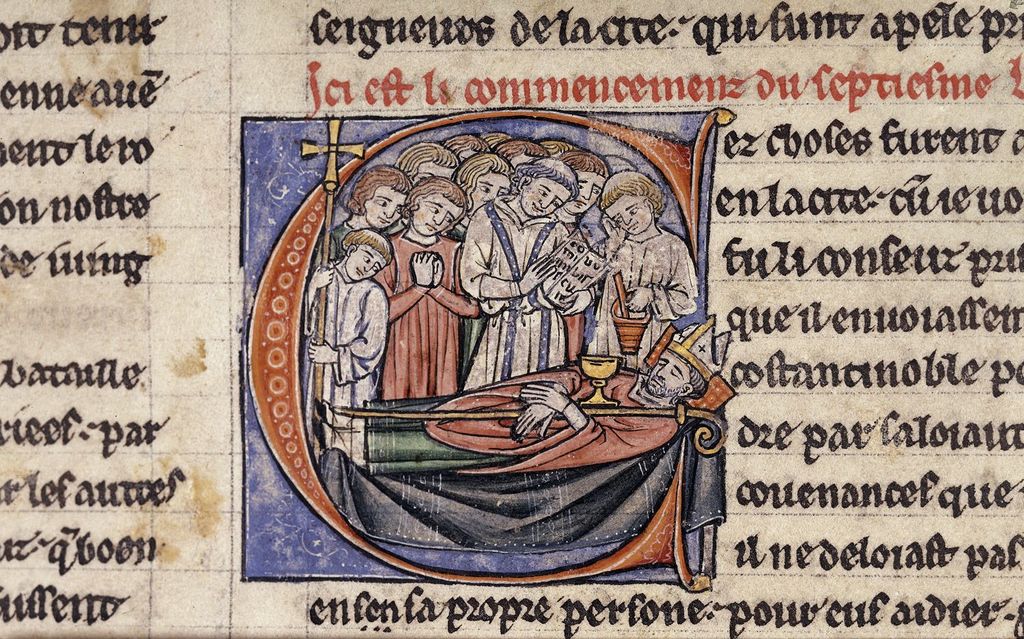Visitors to the minor basilica San Pietro in Vincoli in Rome are met with a somewhat puzzling sight when they come upon a famous sculpture of Michelangelo that adorns the tomb of Pope Julius II. The sculpture in question is of Moses, but what is surprising are the two horns emerging from his forehead. Why did Michelangelo sculpt Moses with horns? The answer has to do with the Vulgate—the Latin translation of the Catholic Bible associated with the early Church Father, St. Jerome.
We’ll get to this question eventually. For now, we will consider the following as we take a brief tour of the origins and history of the Vulgate, culminating in a brief consideration of the continued importance of the Vulgate in the life of the Church today:
- What is the Vulgate?
- Why was the Vulgate written?
- Why was this translation called the “Vulgate”?
- What’s the difference between the Vulgate and the Septuagint?
- Which biblical books are included in the Vulgate?
- How has the Vulgate been revised over time?
- What role does the Vulgate have in the Church today?
The article concludes with a list of recommended resources for further study of the Vulgate.
What is the Vulgate?
The Vulgate is the name later given to St. Jerome’s translation of the Bible into Latin near the turn of the fifth century CE. While most people are aware that Jerome himself did not translate all of the sacred books into Latin (more on this below), the Vulgate is rightly regarded as Jerome’s most significant benefaction to the Church.
Indeed, just a few years ago Pope Francis drew particular attention to the importance of Jerome’s labors in the vineyard of the text when marking the sixteenth centenary of the Doctor of the Church’s death. Jerome’s legacy, according to the current pontiff, has had a lasting impact on the life of the Church and the shape of Western culture:
The result was a true monument that marked the cultural history of the West, shaping its theological language. Jerome’s translation, after initially encountering some rejection, quickly became the common patrimony of both scholars and ordinary believers; hence the name “Vulgate.” Medieval Europe learned to read, pray, and think from the pages of the Bible translated by Jerome. … Literature, art, and even popular language have continually been shaped by Jerome’s translation of the Bible, leaving us great treasures of beauty and devotion.1
Why was the Vulgate written?
Already by the third century CE, translations of the Scriptures were being made into Latin from the Greek Septuagint (LXX). Over the course of roughly two centuries prior to the time of Jerome, these translations (and revisions) were varying in their quality, which had been made from the Greek into Latin. These earlier Latin translations, varied as they may be, are often referred to collectively as the Vetus Latina (“Old Latin”).
Around the year 382 CE, Pope Damasus enlisted the aid of Jerome to revise the Latin edition of the Gospels to establish a sure norm for the Church’s faith and worship. Over the next couple of decades, Jerome would complete the far more ambitious task of further revising and translating anew the biblical texts with respect to the original Greek and Hebrew.2
Jerome’s own preface to the Vulgate translation of the Gospels, addressed to Pope Damasus, is most instructive in revealing the impetus for this monumental undertaking and the disparate nature of the Latin translations of Scripture that existed in his own day prior to this commission from the bishop of Rome:
You urge me to revise the old Latin version, and, as it were, to sit in judgment on the copies of the Scriptures which are now scattered throughout the whole world; and, inasmuch as they differ from one another, you would have me decide which of them agree with the Greek original. The labour is one of love, but at the same time both perilous and presumptuous; for in judging others I must be content to be judged by all. … Now there are two consoling reflections which enable me to bear the odium—in the first place, the command is given by you who are the supreme bishop; and secondly, even on the showing of those who revile us, readings at variance with the early copies cannot be right. For if we are to pin our faith to the Latin texts, it is for our opponents to tell us which; for there are almost as many forms of texts as there are copies.3
Why was this translation called the “Vulgate”?
Lest anyone today be concerned that there was something foul or uncouth about translating the Sacred Scriptures into the tongue of Cicero and Vergil, we should be quick to point out that the Latin term vulgus—from which the name Vulgate (Vulgata) is derived—simply means “common people.”
Thus, the Vulgate came to be called such precisely because it was a translation of the Scriptures (Hebrew, Aramaic, and Greek) into what had become the common language of the Roman Empire by the fourth century CE—namely, Latin.
It is worth noting that Jerome himself never referred to this translation as the Vulgate. Rather, he and other Church Fathers used the language of editio vulgata as the Latin equivalent of the Greek koinē ekdosis to speak about the Septuagint—the Greek translations of the Old Testament.4
The application of the term Vulgate to Jerome’s translation of the Scriptures was definitively made at the Council of Trent (1545–63 CE). In the decree on the edition and use of the sacred books from the Fourth Session, the council fathers applied the phrase vetus et vulgata editio (“old and vulgate edition”)to the Latin translation dating back to Jerome that in the 1100 years or so had gained a sure place in the life of the Church:
Moreover, the same sacred and holy synod, considering that no little utility may accrue to the Church of God, if, out of all the Latin editions, now in circulation of the sacred books, it be known which is to be held as authentic, ordains and declares, that the said old and vulgate edition [vetus et vulgata editio], which, by the long usage of so many ages, has been approved in the Church, be, in public lectures, disputations, preachings, and expositions, held as authentic; and that no one is to dare, or presume to reject it under any pretext soever.5
What’s the difference between the Vulgate and the Septuagint?
As noted above, the language of editio vulgata was used by a number of Church Fathers—Jerome included—to refer to the Septuagint. One straightforward instance of this language is found in Augustine, who in Book 16 of his City of God writes:
Thus the years from the flood to Abraham come to a total of 1,072 according to the common version [vulgatem editionem], that is, according to the Septuagint.6
On the one hand, the difference between what we (now) call the Vulgate and the Septuagint is fairly obvious: the Vulgate is in Latin, and the Septuagint in Greek.
A further fairly straightforward difference has to do with what books comprise each. Whereas the Septuagint contains Greek versions of the Old Testament Scriptures, the Vulgate contains the complete Catholic canon of books in both the Old and New Testaments.
Which biblical books are included in the Vulgate?
The Vulgate contains all seventy-three books of the Catholic canon of Scripture, attested by various local councils in the fourth and fifth centuries and later dogmatically defined at the Council of Trent. Indeed, the excerpt from the decree on the “Edition and Use of the Sacred Books” quoted from Trent above follows immediately after the decree about the canon of Sacred Books
The full Vulgate text that the Church received subsequently contains:7
- The New Testament revised according to the Greek
- The protocanonical books of the Old Testament translated from the Hebrew
- Jerome’s translation of Tobit, Judith, and additions to Daniel and Esther
- Five deuterocanonical books not translated by Jerome (Wisdom, Sirach, Baruch, 1 Maccabees, 2 Maccabees) from the Old Latin version
- The Gallican Psalter corrected by Jerome on the basis of the Septuagint
How has the Vulgate been revised over time?
It is significant to note that the Vulgate translation has undergone a few significant revisions since the time of Jerome. Most notably, the Council of Trent, while establishing the Vulgate as an “authentic” translation, also called for a corrected version of the Vulgate. Nearly three decades after the close of the council, Pope Clement VIII promulgated the Clementine Vulgate.
For centuries, the Clementine Vulgate remained the normative translation for Church, until the Second Vatican Council called for another revision of the Vulgate in order “to revise all the books of Sacred Scripture so that the Church might be enriched with a Latin edition which advancing biblical studies demanded and which might serve especially in the Liturgy.”8 The result of this revision was the Nova Vulgata (“Neo” or “New Vulgate”), which Pope John Paul II promulgated on April 25, 1979.
What role does the Vulgate have in the Church today?
Sixteen hundred years after the death of St. Jerome, his presence continues to be felt through the translation he bequeathed to the Church.
One small but noteworthy example is in the existence of the Douay-Rheims (English) translation of the Scriptures. The D-R was published in 1609, a few years ahead of the KJV. Insofar as the D-R was translated from the Latin Vulgate into English, it continues to be helpful touchpoint for English readers to gain insight into some of the nuances of Biblical text as encountered by many medieval spiritual writers.9
Another way the Vulgate continues to play a pivotal role in the life of the Church is the status of the Nova Vulgata as a key touchstone in the translation of the Scriptures into vernacular languages for use in the Mass. The 2001 instruction Liturgiam Authenticam from the Congregation for Divine Worship and the Sacraments points to the Vulgate as an important norm in this respect:
It is advantageous to be guided by the Nova Vulgata wherever there is a need to choose, from among various possibilities [of translation], that one which is most suited for expressing the manner in which a text has traditionally been read and received within the Latin liturgical tradition.10
One final note on the importance of the Vulgate is worth making. Namely, the Vulgate’s lasting impact on Western culture. Once more, Pope Francis:
By his translation, Jerome succeeded in “inculturating” the Bible in the Latin language and culture. … Just as Jerome’s translation is indebted to the language and culture of classical Latin, whose influence is very evident, so his translation, by its language and its symbolic and highly imaginative content, became in turn an impetus to the creation of a new culture.11
Certainly a visible mark left by Jerome’s translation can be found atop the head of Moses. When it came to the translation of Exodus 34, Jerome translated the Hebrew qārǎn (“to shine, produce a horn”) as cornuta esset (“was horned”) to describe Moses’s face after his encounter with the Lord on Mount Sinai. Instead of the more typical “Moses did not know that the skin of his face shone” (Exod 34:29), readers of the Vulgate and later the Douay-Rheims were faces with the intriguing image that Moses “knew not that his face was horned.” One need not travel to Rome to find a horned Moses. For centuries, many depictions of Moses in Western art have followed the Vulgate and depicted Moses with a bicornual brow.
Yet it is certainly the hidden impact of Jerome’s translation that is more significant in the history of the Church. The language of the Vulgate has been the language of Sacred Scripture for many saints throughout history. Jerome’s words were written in the minds and on the hearts of myriads of Christians throughout the ages. The words of the Vulgate translation were how these men and women heard God speaking to them.
Recommended resources
- Francis, “Scripturae Sacrae Affectus,” Apostolic Letter, Vatican.va, https://www.vatican.va/content/francesco/en/apost_letters/documents/papa-francesco-lettera-ap_20200930_scripturae-sacrae-affectus.html#_ftnref40.
- For those looking to explore the interplay of the original biblical languages with the Latin of the Vulgate, I strongly recommend Verbum’s edition of the Clementine Vulgate with Reverse Interlinear, which allows users to move between the original languages and the Latin text. Furthermore, the Analytical Lexicon of the Vulgate is a tremendous tool for exploring how the Hebrew and Greek texts came over into the Latin.
- Jerome, “Prefaces to the Vulgate Version of the New Testament,” in St. Jerome: Letters and Select Works, eds. Philip Schaff and Henry Wace, trans. W. H. Fremantle, G. Lewis, and W. G. Martley, Select Library of the Nicene and Post-Nicene Fathers of the Christian Church 6, Second Series (New York: Christian Literature Company, 1893), 487–88.
- See Jerome’s own use of the term in his Epistle 57.7, a letter that is specifically concerned with the question of the method of translation
- Theodore Alois Buckley, ed., The Canons and Decrees of the Council of Trent (London: George Routledge and Co., 1851), 19.
- Saint Augustine, The City of God, ed. Boniface Ramsey, trans. William Babcock, The Works of Saint Augustine: A Translation for the 21st Century 7 (Hyde Park, NY: New City Press, 2013), 199. This example is highlighted in the 1915 International Standard Bible Encyclopaedia’s entry on the Vulgate, but the source is mistakenly identified as Augustine’s de doctrina christiana instead of his de civitate dei.
- The following list is adapted fromthe article “Vulgate” in the Catholic Bible Dictionary, ed. Scott Hahn (New York: Doubleday, 2009), 945.
- John Paul II, “Scripturarum Thesaurus,” Apostolic Constitution.
- Hans Boersma makes a similar point in his recent work on lectio divina, Pierced by Love (Lexham, 2023), 9: “I follow the Douay-Rheims Bible from the late sixteenth and early seventeenth centuries. The reason is that it translates the Latin Vulgate, and the spiritual writers I quote mostly followed the Vulgate. The Douay-Rheims Bible thus keeps us closest to the biblical text as these theologians would have known it.”
- “Liturgiam Authenicam, 41. Accessed at https://www.vatican.va/roman_curia/congregations/ccdds/documents/rc_con_ccdds_doc_20010507_liturgiam-authenticam_en.html.
- Francis, “Scripturae Sacrae Affectus,” Apostolic Letter, Vatican.va, https://www.vatican.va/content/francesco/en/apost_letters/documents/papa-francesco-lettera-ap_20200930_scripturae-sacrae-affectus.html#_ftnref40.






